The Data Leader's Ramp-Up Guide (Part 2): Aligning Strategy and Structure in Days 31–60


%20(1).webp)
In Part 1 of this series, we focused on listening, auditing, and laying the groundwork for trust. By now, you’ve built relationships, mapped your stack, and surfaced key themes. You’ve likely delivered a few small wins. Now it’s time to transition from observation to orchestration.
Days 31-60 are all about designing and aligning. It’s your job to make sense of what you've learned, define the role of your team, and chart a path forward that aligns with business goals. This is where you go from student to strategist and executor. You are now out the walk phase, but not quite ready to run.
30-60 Day Plan for Data Leaders: From Discovery to Direction
Objectives for Days 31–60
- Define your data team’s mission and scope
- Align your roadmap with company priorities
- Propose a structure that enables execution
- Launch your first priority project
Key Actions for Data Leaders in Their Second Month
Draft Your Data Team Charter
If your team’s mission isn’t clear, others will define it for you. A strong charter gives your team focus and shields it from randomization. It's meant to be high level.
Include:
- A clear mission (e.g., “Empower the company to make smarter, faster decisions with trustworthy data.”)
- Scope of responsibilities & roles (e.g., analytics, engineering, enablement, governance)
- Team roles: This is where I dive into what roles are on the team. I leave the 'who' for a separate document
- Responsibilities: Overall team responsibilities at a high level. Leave individual responsibilites per role for a seperate document
- Rules and norms: how do we behave and operate - I love including this because it’s indicative of the culture you create within your teams
- Communication Guidelines: I used to put this in rules and norms, but found value in pulling it out. I love creating a slack channel for data questions as well as doing company wide demos on Fridays(drop in if you can) to showcase the team’s work and create strong mechanisms for cross functional communication

I included an example of what Matia’s data team’s charter may look like as we scale. Data by nature is cross functional, but I always run this by key cross functional stakeholders and ask for feedback.
Pro tip: Add a “What We Don’t Do” section to clarify scope and set expectations with stakeholders.
Make sure to make a note to revisit this every 6 months at least, and more frequently if you are in hypergrowth mode.
Prioritize High-Impact Data Use Cases
Revisit your stakeholder interviews and team feedback. Create a list of up to 10 projects or initiatives as possible candidates for consideration. Make sure you also identify the stakeholder or department requesting this, as it’s important to not look like you’re spending all of your time in one department’s projects.
From here, we’re going to create a prioritization matrix for the best use cases to tackle early. Plot your candidate projects on a 2x2 grid based on impact and effort. For high impact, low effort projects (my favorite),I label them as quick wins. High impact, high effort are strategic bets; low impact, low efforts are classified as Nice-to-haves, and low-impact, high-effort we refer to as time sinks.
Here’s what it might look like:

Example Quick Win: Consistent funnel metrics and Launch self-reporting MVP
Example to Avoid for Now: historical revenue dashboard
Use this matrix in team discussions to align on what “good” looks like and avoid overcommitting.
Prioritization criteria:
- Unblocks key business decisions
- Supports top-line growth or efficiency
- Has visible pain and measurable outcomes
- Can be completed (or piloted) in ~4 weeks, with quick wins in under two
In the example above, we choose to move forward with three key projects: Consistent funnel metrics, launch self-serve reporting, and rollout unified PLG dashboard. We chose one quick win projects, and one. We tried to balance everything so every department felt represented in the work we were tackling first
When it came to the strategic bets, although every stakeholder may want their project prioritized, we chose to understand the WHY behind everything and see if there was anything we could deliver quickly. For example, the marketing team requested rebuilding marketing attribution. I rarely have hard and fast rules in a data team, but this is always a project I would heavily caution data leaders from taking on first (if you know, you know). However, when we chatted with the marketing team and more specifically the demand generation and growth lead, we realized that if we helped define more consistent funnel metrics with them, which was the root of the pain they were feeling, we could deliver that quicker, help their alignment with sales, and focus on higher priority items.
Understanding the why can also turn the time sinks into quick wins. Take the Historical Revenue Dashboard, for example — a project that may initially feel heavy, complex, and destined for the backlog. This exact scenario happened to me before. When I asked finance why they needed it, we uncovered a more urgent, solvable need: reliable month-over-month growth numbers for board reporting. Instead of rebuilding historical revenue from scratch, we quickly shipped a clean, automated extract of MRR by month from the current CRM. It solved 80% of their problem in a fraction of the time. By clarifying the pain point behind the ask, we created trust and freed up the team for more strategic work and were able to deepen our relationship with that team.
Propose Your Ideal Data Org Structure
Even without a formal reorg, sketch the ideal structure for delivery and scale.
Questions to consider:
- Is the team centralized or embedded?
- Where are the skill gaps?
- Who owns the data lifecycle management , from ETL/ingestion to insight and dashboard?
Deliverable idea:
Create a RACI chart to clarify who owns modeling, dashboards, governance, and requests.
If hiring is needed, draft job descriptions that tie technical skills to business outcomes.
RACI chart can be simple, but here’s how it typically looks at data organization i’ve been a part of. Ever org is different and structures things differently. A slack channel is a great way to keep people informed
Establish a Clear Operating Cadence
Strong teams have structure. Now’s the time to introduce light but effective rhythms that support delivery.
Suggestions:
- Weekly team standups (15 mins max)
- Biweekly stakeholder check-ins
- Monthly reviews of KPIs and roadmap
- Sprint planning or project kickoff sessions
Keep the overhead low. The goal is clarity, not calendar bloat.
Bonus: Add a rotating “Data Demo” segment to team meetings to showcase recent work.
Launch and Communicate Your First Initiative
Pick one use case and commit. Your first project should demonstrate the team’s ability to drive business value.
Checklist for kickoff:
- Problem statement and success metrics
- Key stakeholders and timeline
- Data sources, blockers, and assumptions
- Communication plan and ownership
Good pilot project examples:
- Building an MVP of a large project (make sure you’re aligned on what MVP means) - i always love a self-service mechanism
- One large scale unified project (see rebuilding unified PLG dashboard above)
Try to solve what you can with the tools and stack you currently have in place. Is your data not moving to the warehouse efficiently and you may need to look at your ETL solution? Are you seeing a lot of anomalies and stakeholder mistrust of data with existing dashboards? Maybe you need to look at an observability strategy. Resist the temptation to buy anything.
Take note of the pains and inefficiencies as you’re doing it. You’ll want to revisit this shortly.
How to Communicate Early Wins as a Data Leader
Execution is only valuable if others know about it. Communicate clearly and consistently.
Ideas for sharing wins
- Before/after screenshots in team Slack
- #data-questions slack channel for async Q&A
- 90-second Loom videos walking through new dashboards
- Monthly “Data Wins” roundup email
- Share roadmap and results at all-hands or ops syncs
- Bi-weekly live data demos - bonus if you let your team really present and just be the one to set it up
Visibility builds credibility. Credibility builds momentum.
Common Pitfalls to Avoid Between Days 31–60
Avoid these missteps that can slow down your progress:
- Trying to fix everything: prioritize for impact, not coverage
- Introducing tools without understanding the root problem
- Becoming a bottleneck for every decision. If you have a team, be clear about where you want input and where you just want visibility. That clarity prevents bottlenecks.
- This will also help your relationships
- Skipping documentation: your future team will thank you
- Working in isolation: build with, not just for, stakeholders
Deliverables to Complete by Day 60
Here’s what great looks like by the end of this phase:
- A well-socialized data team charter
- A prioritized roadmap of use cases
- A proposed org structure with roles and ownership
- One visible, high-value project in motion
- A defined team operating cadence
- A simple feedback intake mechanism (e.g., a form or shared doc) - it can be a simple google form that creates a jira ticket
Final Thought: Build with Intention
The next 30 days are your bridge from learning to leading. A clear strategy, a confident plan, and a well-structured team set the tone for everything that comes next.
Coming up: Part 3 – Days 61–90: Execute and Empower. Make sure to review Part 1 as well.


.svg)





.png)









